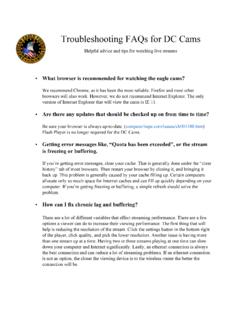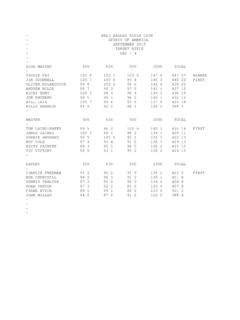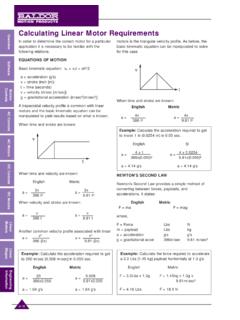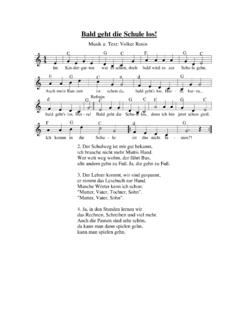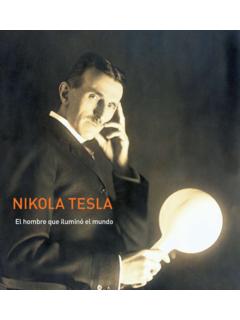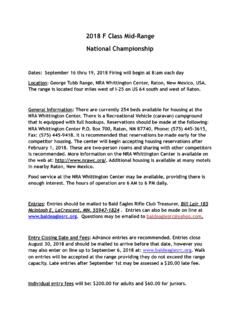Transcription of DC#Eagle#Nest#FAQs …
1 1 DC Eagle Nest FAQs How do you tell Mr. President and The First Lady apart? This is our second season observing Mr. President and The First Lady so we are still learning about this pair but hopefully some of the things below will help you in identifying the adults. The First Lady is larger, her beak is a paler yellow, and she has lighter tipped feathers. She has two lighter spots on her back near her tail, her beak has a slight curve, and she has some indentations on the top of her beak. She has some dark feathers throughout on her head & neck, and also has a dark streak on the right side of her tail.
2 Mr. President is the smaller of the two, is darker, and has a brighter yellow beak which appears to be straighter. He sometimes has a visible blaze of white feathers down his chest area. He has a dark spot near his left eye that is usually visible in profile. Sometimes it is hard to distinguish one from the other, depending on lighting and how they are sitting in the nest. @N07/albums/72157664614930711 What is the light shining on the nest and why is my stream in black and white? The light you see is an infrared light which the Eagles cannot see.
3 To the eagles, the nest is dark at night. We've installed low power IR illumination devices that are 7- 10 feet from the nest. They do not emit heat, dangerous radiation, or noise. A small chip inside the camera does the job of converting the IR image into visible light through tiny electric charges. Images coming from IR cams will be in monochrome since the chip does not detect color. Here's a link that may help to understand more about IR cams. @N07/15346063397/in/album- 72157636759692955 How do eagles mate/copulate and how often?
4 Mating happens by pressing cloaca together This is also known as the cloacal kiss . The female will lean forward, the male will land on her back. The female will move her tail feathers to one side, the male will press and twist his cloacal opening around her cloaca, passing the sperm from his cloaca to hers. Generally, eagles may mate throughout the year depending on if the pair migrates. Frequent mating strengthens their bond to each other and increases the chance of fertile eggs, the female may have 3 two week windows throughout a breeding season where she is fertile.
5 The male s sperm is said to be viable inside the female for 10 days. Increasing daylight hours causes the females pituitary gland to secrete a hormone that turns on the ova. The ova is turned off by prolactin which is the hormone associated with incubation. How soon after a successful copulation will eggs be laid? It is believed that an egg is typically laid 5- 10 days after successful copulation. Each egg is typically laid about 3- 5 days apart. How are the eggs fertilized? The sperm travels up the oviduct (tube connecting to the ovary) to reach the ovum (the female reproductive cell, which is capable of developing, usually only after fertilization, a new individual) at the infundibulum (This is where the fertilization happens).
6 The sperm fertilizes the ovum by penetrating the yolk, then the outer egg membrane seals off which prevents further sperm entry and the fertilized egg can now begin the 3- day journey down the oviduct. The yolk will provide food and nutrients for the developing chick, the white will keep the yolk from drying out and give it physical support. Membranes are formed around the yolk and egg white, and different layers of shell are added, and then the egg is laid. The shell is mostly made up of calcium carbonate the same chemical formula as limestone making it hard yet brittle.
7 The process continues for each new egg that is laid every 3- 5 days or so until the full clutch of 2 or 3 and rarely 4 eggs are laid. 2 How are eggs formed? There is an average of 25 hours between ovulation and oviposition (laying) in chickens and the egg rotates slowly as it progresses. The yolk is deposited in rings while in the ovary. Once the egg is released, fertilization occurs in the infundibulum (takes about 15 minutes to pass through). The egg next moves through the magnum over a 2- 3 hour period. Here, the albumen is secreted in four layers: inner thick (chalaziferous), inner liquid, outer dense (albuminous sac), and outer liquid.
8 The albumen is a water and protein source for the embryo and also cushions the embryo and deters infectious agents. During the next hour the egg moves through the isthmus(a narrow organ, passage, or piece of tissue connecting two larger parts), where two nonliving shell membranes are laid down to act as a matrix supporting shell formation. The shell membranes are composed of keratin- like fibers and pigment and act as a mechanical barrier to infection. The longest part of egg formation takes place when the egg moves through the shell gland or uterus, which takes about 20- 23 hours.
9 Here is where the shell, pigment, and cuticle are laid down. The shell acts as physical protection for the embryo and is the primary source of calcium for the developing embryo. The shell also acts as the first barrier to infection. This is a mechanical barrier which is based upon pore size and length. The cuticle acts as a further mechanical barrier to infection by partially occluding the pores in the shell. Lastly, the egg passes through the vagina and cloaca before it is finally oviposited (laid). Source: IWS Assuming the egg(s) fertile, how long will the egg(s) be incubated?
10 The adult eagles will both incubate the egg(s), typically, hatching will occur after 35- 38 days but we've observed hatching at 41 days of incubation. What is incubation? Incubation is the process of sitting upon(eggs) for the purpose of hatching and to maintain the eggs at a favorable temperature and in other conditions promoting development. The eagle pair will sit on the egg(s) to bring them up to a certain temperature (94- 105 degrees F) which will set development into motion, it may begin after the first egg is laid, meaning that in a nest with more than one egg there will be an oldest sibling, a younger sibling, and occasionally a middle sibling.
